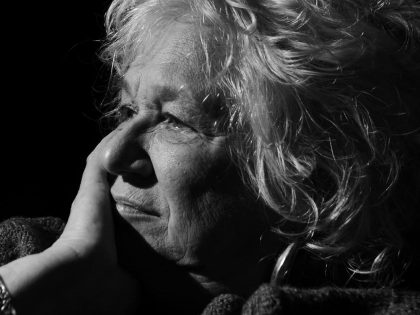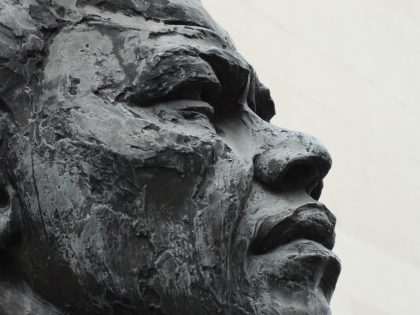The virtual reality of Walter Sisulu
While Sisulu's political career is less celebrated than Nelson Mandela, it was as remarkable.

Still from film "Accused No. 2: Walter Sisulu."
When Walter Sisulu passed away in 2003, at age 90, some obituaries described him as “one of Nelson Mandela’s earliest political mentors and his closest collaborator for half a century in the campaign against South Africa’s racist political order.” The two men had served time together on Robben Island and Victor Verster prisons for conspiring to overthrow the apartheid state. As The New York Times concluded in its obituary, “Mr. Sisulu’s political career was less celebrated than Mr. Mandela’s but not much less remarkable.”
One of the last public events associated with Mr. Sisulu before he went to prison was the Rivonia Trial where, along with Nelson Mandela, he was sentenced to life in prison. The short VR film “Accused No. 2: Walter Sisulu,” transforms archival audio of that trial into an immersive retelling of the courtroom drama as Sisulu, Mandela and other top anti-apartheid leaders defended themselves.
Produced by French filmmakers Nicolas Champeaux and Gilles Porte, the film has been screened at the International Documentary Film Festival Amsterdam, Munich International Film Festival, Tribeca Film Festival and several other international documentary film festivals.

The film places you first in the middle of the courtroom action, under the imposing judge’s seat and next to the witness stand. The 360° animation is charcoal drawing style artwork, bringing a stylized element to the environment and weaving neatly with the scratchy audio recordings. Walter Sisulu is called forward and the interplay between him and the rest of the court begins. His defense attorney explores Sisulu’s background and then the imperious prosecutor Percy Yutar drills into him, all while he resolutely answers each inquiry. The filmmakers take advantage of their chosen form by morphing the size of the characters and periodically interrupt the court scene with metaphorical black circles and white squares to illustrate the struggle of the non-white African in South Africa. The courtroom scene ends as Sisulu reacts in frustration to Yutar’s interrogation, “I wish you were in the position of an African in this country! I wish you were an African and knew the situation in this country!” At the end of the film, we see a triumphal scene of Mandela’s later presidential inauguration, with Walter Sisulu at his side.
Sisulu, with Mandela and others, along with their influential wives (Winnie Madikizela Mandela and Albertina Sisulu), led the postwar movement to challenge the increasingly brutal policies of the white ruling government in South Africa. Mandela’s prominence has overshadowed his quieter ally internationally, an imbalance this film attempts to correct. The short VR story left me wanting to know even more about the subject and surrounding historical proceedings.
Walter Sisulu, born in South Africa’s Transkei (to a Xhosa mother and a white father), moved to Johannesburg for work in 1928 where he eventually met Mandela and became involved in nationalist politics. He held various jobs over the years—gold miner, a domestic servant, a baker and a factory worker—before establishing himself as a real estate agent. Along with other young ANC members like Mandela (then a young lawyer) and Oliver Tambo, (another lawyer), Sisulu helped build the ANC’s mass base and its alliances across racial lines.

Sisulu also played a key role in the ANC’s decision to adopt violence in the wake of a 1961 police massacre of ordinary Africans protesting further restrictions on their movements via Pass Laws. He had been arrested and acquitted already before his arrest and sentencing in 1964. In prison he emerged, along with Ahmed Kathrada, as one of Mandela’s closest advisors. He was released from prison in 1989 along with Kathrada, a few months before Mandela, and lived to see the transition to democracy. (Some of his children ended up as government ministers.)
We continue to struggle in the 21st Century against the forces of racism, xenophobia, and corruption. South Africa has a journey ahead to fully achieve a society built on multiracial equality. The physical and rhetorical violence in the US, set free in the public square by the 2016 election, demonstrate how premature the expectations of a post-racial America really were. In the midst of these uncertain times, I look to the triumphs of our historical progress for insight and inspiration.
When the viewer first steps into the world of “Accused No. 2,” the epochal words of Mandela roll out to an animation not unlike a heart monitor, declaring, “… I have cherished the ideal of a democratic and free society in which all people will live together in harmony and with equal opportunities. It is an ideal for which I hope to live for and to see realized. But, My Lord, if it needs to be, it is an ideal for which I am prepared to die.” The focus of this film is not, of course, on the charismatic figure of Mandela, but on his confidant Walter Sisulu. Champeaux and Porte have built an immersive world for viewers to be in the room as the anti-apartheid leaders displayed dignity in the face of ruthless oppression. This film creates space for reflection on lessons learned in past freedom struggles; particularly important as we continue to work for a better world.



